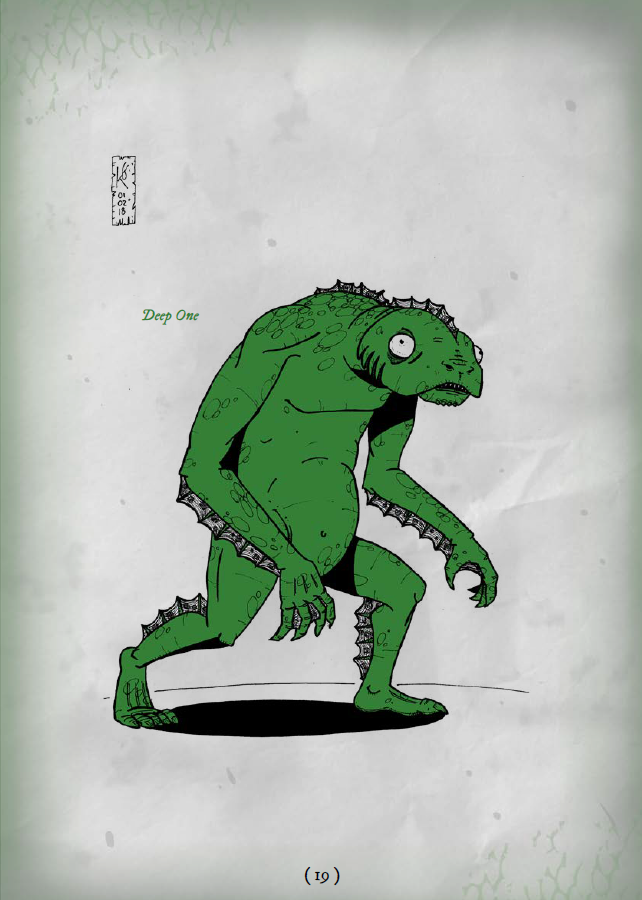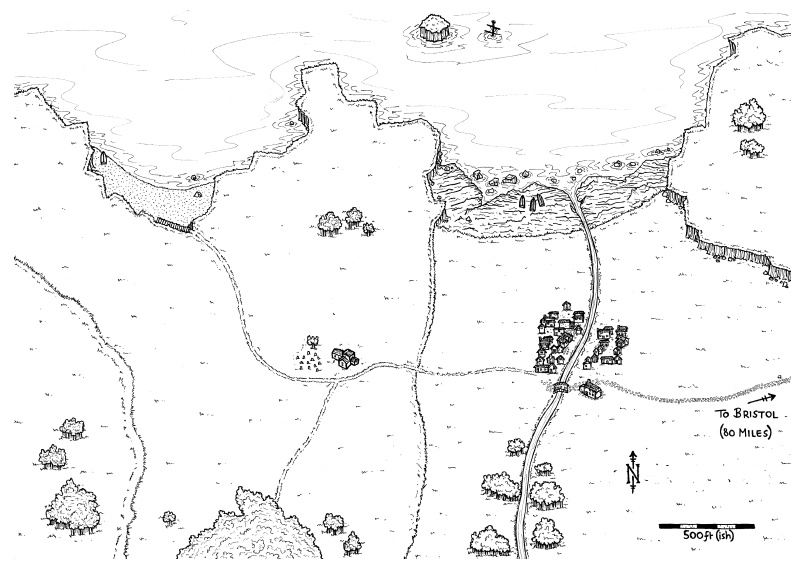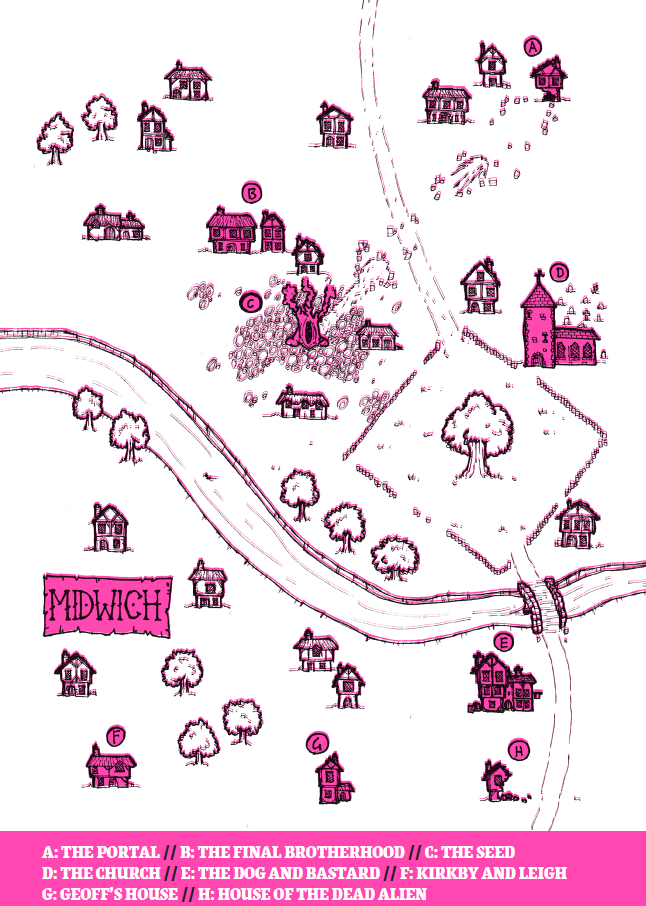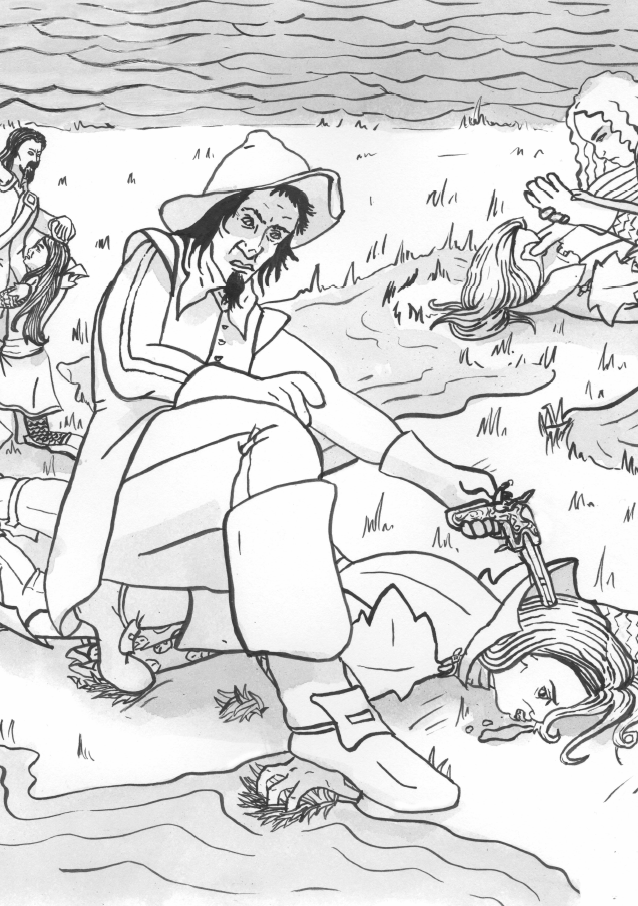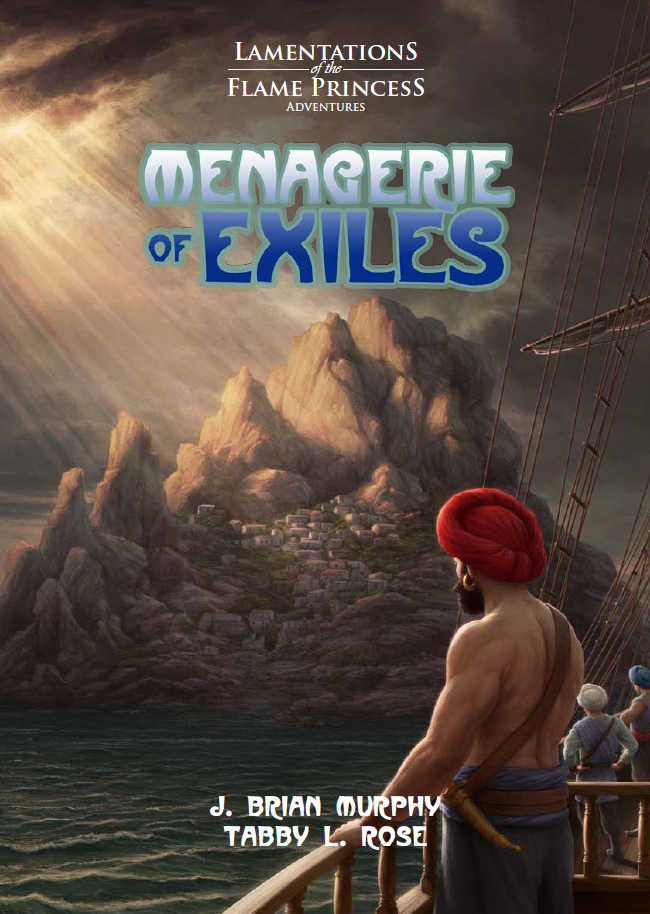This is my personal attempt to create a version of my favourite Indy RPG that works in the FATE system, so that I may run it with ease with new players who may not have access to the original game or who just couldn’t wrap their heads around the original rules or system. If you find this interesting, please support the original works at:
http://adept-press.com/games-fantasy-horror/sorcerer/
Sorcerer and Demon Basics
Crucial Mechanic: in Sorcerer, successes on one roll would carry to the next if the rolls were related. Shifts from one roll carry to the next roll if appropriately related, e.g. Contact succeeds with 3 shifts, then Summoning gets +3 to the roll.
SORCERERS
Humanity: Will try this as a Stress Bar, but one that only reduces when a character does something to redeem themselves. Humanity starts equal to Physique or Will, whichever is higher. When marking off Humanity Stress you mark from the highest down, and when gaining you go in reverse. Any gain beyond your starting max gives an extra box, to a maximum of ten. Actions which test Humanity (Contacting, Summoning, Binding, and Pacting with Demons, also Actions of Questionable Morality) will require an Overcome or increase Humanity Stress. Banishing any Demon which has a Power equal to or higher than your current Humanity warrants a roll to gain Humanity. When Humanity Stress is full, the character is Taken Out. If a character is Taken Out due to Humanity Loss they become unplayably inhumane.
Sorcery Rituals: Contact, Summon, Bind, Punish, Pact. Each of these requires a skill roll against the Demon involved. Binding always works, but the roll determines who has the advantage in the relationship.
Price: Sorcery comes at a price. This price will be reflected in the character’s Trouble. What price have you paid to become the powerful Sorcerer that you are? This can change through the narrative of the game to become more serious as the character progresses.
Telltale: this is an extra Aspect that comes after High Concept or Price (Trouble) and is something that gives the character away to people in the know. It can be a detail of physical appearance, dress or hairstyle, or even a mannerism or speech pattern. It doesn’t have to be overly obvious or informative, but must be specific and precise.
Required Skills for Sorcerers: Physique is the available energy the character expresses through physical acts. Will represents force of personality, presence of mind, clarity of thought. Lore specifically defines sorcerous training. Non-sorcerers cannot have the Lore skill, but substitute Knowledge instead. (Note that even a Lore of +1 can still use Sorcery, they just are more of a naive user than a trained one.)
Cover: in most settings, Sorcerer is not a viable job description. Your characters Cover is shown in what other skills you take.
DEMONS
Type: there are many types of Demons. Each Demon has a Telltale of its own, which may be wondered at by a suspisious person. A Sorcerer may roll to identify a Demon using their Lore skill. Default difficulty is +1 unless the Demon has a stunt to increase this. A list of Types follows:
Inconspicuous: these Demons are hard to perceive. They almost always have the ability to Cloak themselves. They may merely be small, or they may be composed of something like shadows or light or mist, or they may be able to make themselves invisible. Inconspicuous Demons may not carry out obvious actions and remain unnoticed! Even an invisible Demon becomes obvious if it is tearing someone’s head off! They may confer their abilities to themselves or another as defined per ability, and they may have the Boost ability.
Object: these Demons are invested into physical items and usually must be carried around. They can act and move, but in that behind-your-back way that all inanimate objects seem to have once in a while. They may have the Boost ability, and they may confer their abilities upon themselves or another. Their Physique refers to their physical toughness and capacity to use abilities only as they cannot usually carry out independent physical acts.
Parasite: these Demons must live inside a host, usually the summoner and/or binder but not necessarily. They may be actual critters nestled into some body cavity, or they may exist only as an agent in the bloodstream or nervous system. Their powers confer onto the host alone, except for Boost. Boost and Vitality are common.
Passing: these Demons look almost perfectly human or animal, and they mix directly into society, which is why they almost always have the ability Cover. They have a natural physical attack. Their powers confer upon themselves alone, and they may not have the ability boost.
Possessor: these Demons completely supplant another being from its body, using their Power versus the hosts Physique. If the takeover is successful, the host remains as a flickering bit of consciousness barely hanging on, unless the Demon gained a number of shifts greater than his/her Humanity, in which case the host personality dies. Possessors have a natural attack corresponding the the body they inhabit, e.g. in a human body they can attack with their fists, etc. Their abilities may not be conferred, and they may not have the ability Boost. They may or may not have the ability Cover, but if they do they can use it to mimic their host. Many Possessors are limited to certain types of hosts, as defined for the particular Demon.
DEMON CHARACTERS
I will attempt to use customised FAE character sheets for the Demons in this hack. Instead of 6 approaches, Demons will have 4 Scores: Stamina, Will, Lore, and Power. Demon abilities will work as Stunts. Demons also have aspects like normal FAE characters, including a Trouble and Telltale. Their High Concept will describe their Type and maybe something about their personality. Their Need and Desire will also be included amongst their aspects.
First choose it’s Type and appropriate Telltale.
Demon Scores – a Demon has a Lore equal to the number of Abilities given to it. Set it’s Stamina based on how physically tough you think it should be. It’s Will should be one higher than either Lore or Stamina, whichever is higher. Power is equal to Will.
Desire – every Demon has a special interest and it will urge its master into situations that give it a chance to indulge. A Demon frustrated in its Desire may well become cranky and rebel. Example Desires are Mayhem, Mischief, Corruption, Power, Sensual Gratification, Creation/Artistry, Knowledge, Competition.
Need – every Demon has a Need to do or get something. Binding gives the Sorcerer responsibility to help or allow the Demon to meet its Need; failing to offer this incentive in a Binding contract will confer a -5 Penalty to the Sorcerer’s roll. A Bound Demon gains a +1 bonus to its rebellion rolls for every week or so that its Need goes unmet. If a Need is being unmet, the Demon will suffer badly, as described in the Rule of Need below.
A Need may be fulfilled by the Demon actually doing something, or maybe it just has to be present while something is done. Needs often reflect the Demons’ Desires, but they don’t have to; for example, familiar Demons may merely have to drink their masters’ blood with their Desires varying widely. Sometimes the connection is a little oblique; a mayhem-Desiring Demon may have a Need to gamble. The GM should make sure that Demons’ Needs are not just silly.
Needs may vary extremely widely and are left to the play group’s imagination, but the GM may use the following guidelines to tell players what sort of Needs are appropriate.
– Gross and Savage: eat small animals, drink human blood
– Annoying: sing loudly, overtly come on to possible sexual partners, start fights, disassemble household appliances
– Plot Movers: make bets, follow the news, hack into the internet, follow people, eat other Demons
– Trivial: get ears scratched, stay clean, meditate regularly
The Three Rules
All Demons share three concerns: the Rule of Binding, the Rule of Need, and the Rule of Secrecy. All Demons get a +5 bonus to refuse commands that contradict these concerns.
The Rule of Binding: if they are present in (Summoned to) reality but are not Bound, they will start to shrivel up and eventually will be automatically Banished.
The Rule of Need: if they are in Need, they will react the same way, basically starving to death, or rather, Banishment. If the Demon is a Possessor or a Parasite, it will suffer in just the same way if it does not have a host.
An unBound Demon, a Demon without its Need, and a Parasite or Possessor without a host will lose 1 Power per day until is is down to zero, in which case it must start making Will rolls to make any roll (Will vs. Bonus desired up to maximum appropriate Score). At that point it will lose 1 Stamina per day unless it rolls its Power successfully vs. original Stamina. Once its Stamina hits 0, the Demon is automatically Banished. These effects are cumulative: an unBound, unhosted, Parasite in Need will lose 3 Power per day and then 3 Stamina per day.
The Rule of Secrecy: no Demon will tolerate a command to appear or use its abilities in a way that seriously risks widespread knowledge of its existence.
As explained above, Demons, not their masters, ultimately control Demon abilities. Either they are the user of the ability, meaning they control them completely, or someone else is the user, in which case the Demon still has control over whether the user can have the ability in the first place. At times they will refuse to use or to confer their powers. They should be played as characters, including most notably 1) the ability to lie, and 2) perfect freedom of movement and communication within their definitions.
Individual demons’ attitudes are very important for this game to work. Demons have relationships with one another, especially if they’re Bound to the same master, and they care about things, especially their Desires. Their dialogue and assertions will more than anything else set the tone of the story.
DEMON ABILITIES
Some important terms:
– a Master is whomever the Demon is bound to.
– a Host is whomever/whatever a Possessor or Parasite occupies.
– a User is whoever controls a given Demon ability.
– a Target is the victim of an offensive power.
The user must be defined when an ability is taken. If the Demon is not the user, think of the user as the one clicking a light switch up and down while the Demon crouches at the circuit breaker deciding whether the light switch will work at all.
Demon Abilities – a Demon has abilities equal to its Lore, and each ability has a bonus equal to its Power. Actual visual or other sensory aspects are determined by the player and GM, but they should be obvious and dramatic!
Armor – the user ignores damage shifts equal to the Demon’s Power taken from edged, blunt, or projectile weapons. It has no effect on damage from heat, poison, gas, or anything other than basic weapon or hand-to-hand damage.
Big – the user becomes very large, anywhere from bear to mastodon-sized, and his or her Physique is increased by the Demon’s Power for purposes of resisting damage and endurance only. Without this ability, Passing or Inconspicuous Demons may be dwarf-sized to largish-human-sized. A Parasite or Possessor, of course, is defined by the size of its host.
Boost – the Demon’s Power is added to a given skill of the target for one act. The skill affected is chosen with taking the ability, so if one wanted a Parasite to Boost Stamina and Lore, the demon would have to take two separate abilities. Boosting reduces the Demon’s Power to 1 while it is maintained, decreasing all of its other abilities accordingly. Also, receiving two Boosts of any kind in rapid succession results in the recipient being Confused as per the ability below. Boost cannot be combined with Ranged. Boost cannot be conferred; the Demon is always the user.
Cloak – the Demon’s Power is added to the difficulty of any attempts to Notice it. Inconspicuous Demons already have a passive Cloack operating on themselves for free; other Demons must take it as an ability and state it as an action.
Command – the user may control one general sort of nonhuman animal with a with a Will vs. Will roll. Most animals Will score is 2. The number of individuals controllable at once equals the Demon’s Power (doubled for animals under one kilogram); only one roll is required for all individuals.
Confuse – the user matches the Demon’s Power against the target’s Will to force the target to lose his or her next action, either later in that round or in the next round. This ability is automatically Ranged.
Cover – the user is proficient in any skills associated with a given profession or social status, using a bonus equal to the Demon’s Power. Possessor Demons automatically have this ability.
Daze – the user hits the target with an Attack roll to subtract the Demon’s Power from all the target’s Notice rolls; the effect lasts for the Demon’s Power in minutes. Note that the target is not blinded and needs no Notice rolls to deal with direct attacks or other obvious things. This ability is automatically Ranged.
Fast – the user adds the Demon’s Power to any skill rolled or used to determine initiative. If the demon is the user that is a +1 at least. The user may include more activities in a combat round than is usually possible.
Hold – requires a regular Attack roll; target can’t change position unless he makes a Physique vs. Power roll. A target may be hit by more than one separated Hold. A single Hold does not prevent actions besides shifting places, but a second Hold will prevent motions like shooting, hitting, or thrashing. The third immobilises the target completely. Multiple Holds must be broken separately.
Hop – a Possessor Demon with Hop may change hosts freely, leaving behind either a shaken but essentially okay host or a corpse (depending on the original Possessing roll). The Demon does have to be in touching range, unless Ranged is taken; the Hop effect is visible and obvious unless Cloak is taken. Without this ability, a Possessor cannot leave a host until the host is physically killed. In either case, once separated, it suffers as if it were in Need until a new host is taken.
Link – the Demon and its master can know each other’s whereabouts and gain some idea of what is happening around the other. They do not gain telepathic or empathic communication, with one exception: the Sorcerer may command the Demon to return immediately. Link only needs to be taken once.
Mark – the target rolls Humanity vs. the Demon’s Power; failure means anyone or thing with Lore +1 or higher will thereafter perceive the individual as Marked, permanently. A Sorcerer may remove a Mark by successfully rolling Lore vs. Demon’s Power. A Mark is not perceptible to individuals with no Lore skill, including the target. The act of Marking is obvious unless Cloaked. Marks may be generic or individually recognisable, depending on the group’s definition of sorcery.
Perception – user adds the Demon’s Power to Notice or whatever skill is being used for perception. Exactly what is perceived must be defined at the outset. The effect can be aura reading, infrared vision, smell, or whatever, but not telepathy or “mind-sense” of any kind.
Protection – the Demon’s Power is added to user’s Defend roll against damage from Psychic Force or one non-impact form of attack (for example, most of the versions of Special Damage below). The type of attack it protects against must be defined at the outset.
Psychic Force – the user may use his or her Will as a ranged attack. People without this ability Defend with their own Will; users defend with their Will or the Demon’s Power, whichever is higher.
Ranged – one Attack (some form of Special Damage, Hold, or Hop) can be made at a distance. The Demon’s Power sets how far the attack may go, in meters.
Shadow – the user controls degree of illumination in the immediate area (about the size of a big room or small auditorium), which must be at least partly enclosed. Despite the name, Shadow allows light changes ranging from strong indirect sunlight to absolute blackness. The effect can be sustained for minutes equal to Demon’s Power.
Shapeshift – the user has another shape, which can be maintained for minutes equal to Demon’s Power. The new shape may have it’s own special abilities, which may be bought separately. Shapeshift should not be confused with an Inconspicuous Demon becoming conspicuous to attack or do something directly, which can sometimes look similar.
Special Damage – the user gains an Attack which adds the Demon’s Power to damage shifts. The use still must use a normal Attack roll to hit a target. The attack must be defined, and unless combined with Cloak that attack proceeds from some obvious action of the user. Some possible definitions include energy discharge (fire, lightning, sonic, etc.), disease/rot, body malfunction (convulsions, asphyxiation), claws/fangs, apparently normal weapons, poison (gas or fluid). A Possessor, Inconspicuous, or Passing Demon has a natural attack even without this ability, but Parasites and Objects do not.
Taint – the target makes a Humanity vs. Demon’s Power roll; failure means loss of a Humanity. The special effect includes physical as well as psychic malformation, with the details being left to the individual play group. Unlike real Humanity Loss, though, the Humanity will return in a few days. This ability is limited to games where players don’t mind losing Humanity for reasons that aren’t their fault, and are willing to role-play the effects, up to and including temporary loss of their characters.
Transport – the user may carry others comfortably during movement, including Travel; the passengers’ combined Physique may not exceed the Demon’s Power.
Travel – the user has the Demon’s Power as a multiple of normal human movement, and can keep going without a break for its Physique in hours. Travel may be defined as flight, teleportation, or any other mode of travel permitted by the GM. A Demon without Travel has the speed and endurance capabilities of a human with its Physique, although how it moves is left up to the player. If its movement abilities give it special plot capabilities, though, it needs to have Travel. Note that Object Demons may have Travel too. Travel may include simply a faster or improved version of norma human-type movement, unnatural movement like running on water or flying, or totally weird stuff such as teleporting or dimension-walking.
Vitality – Consequences up to the Demon’s Power are removed when the user takes a rest following combat. Vitality also confers resistance to raging, but not total immunity.
Warp – the user may alter the shape of unloving material, up to its Power in kilograms squared. It will not animate material but simply give it a new shape. The effect lasts for hours equal to the Demon’s Power. If any damage is to be done by this act, then the Demon must also have Special Damage; if any feature of the warped object is enhanced or strengthened, it must have Boost; it must be able to perceive the level at which it is Warping, which may require Perception.
SORCERY MECHANICS AND RITUALS
More than Mere Mortals – a Sorcerer can use their Will to push on even when they’ve been Taken Out. The Sorcerer can roll Will vs. whatever bonus he or she is hoping to use for a Skill to do an action despite being “Down”. If he or she takes any more damage that cannot be assigned to Stress and/or Consequences then they are Finished, but until such time they can push on even with their guts strewn on the floor before them, missing limbs, etc.
Sorcery – all Sorcerers can do the following rituals at any time during play: Contact, Summon, Bind, Punish, Banish, and Contain. Demons cannot perform sorcery. All of the rituals take from half an hour to three hours to perform correctly. A Sorcerer can attempt to speed things up, like Banishing a Demon right there in combat, for example, but in doing so his or her relevant ritual skill is reduced to +1.
Contact – Sorcerer’s Lore vs. Demon’s Power. Contacting a demon requires expanding one’s mind well out of commonly-acknowledged boundaries. The Sorcerer’s Lore is matched against the Demon’s Power.
Bonuses are awarded for massive doses of hallucinogens refined by the Sorcerer for this use. For every hit dropped, award the Sorcerer one die as a bonus. However, there is a cost to this sort of activity: at the end of the Contact attempt, successful or not, the Sorcerer must roll his or her Will vs. the number of hits dropped. Failure means that his or her Will is impaired by one for several weeks; if they lose by 3 shifts or more this loss is permanent!
One can continue to attempt a Contact even after a failed roll, with a penalty of 1 to Lore and Physique per extra attempt. If the cumulative penalties bring Lore to +0 the Sorcerer is catatonic for several hours; if they bring Physique to +0 he or she faints, again for several hours.
A player may describe a Demon for his or her character to Contact, even specifying numerically if he or she wants, but the GM can always alter the Demon who actually shows up. (see Contacts and Summons During Play below).
Once Contacted, a demon can be perceived and spoken to; any kind of information can be exchanged. But there is no way for either Sorcerer or Demon to affect one another, either physically or in terms of Binding, unless the Demon is Summoned. The communication stays open, so to speak, for about an hour, unless the Sorcerer terminates the Contact or makes another Contact roll to prolong it.
Summon – Sorcerer’s Will – Humanity vs. Demon’s Power. Summoning a Demon may only be attempted if it has been Contacted, whether by the summoner or by someone else. All Demons want to be Summoned and will not resist; the only thing that the Sorcerer must overcome with his or her Will (modified by Humanity) is the Demon’s intrinsic Power. The same penalties to Physique incurred by repeated attempts to Contact also apply to Summon. A summoned Demon is not automatically Bound, which is why the wise Sorcerer may perform a Contain ritual before trying.
One method for improving the chances to Summon is a sacrifice: killing a living thing during the ritual. The victim’s Physique or Will, whichever is higher, is used as a one-time bonus to the roll. The social disadvantages of making this practice a habit should be clear to both players and GM; furthermore, performing a sacrifice entails making another Humanity check. If it is a Human sacrifice, the check is made against the victim’s Humanity instead of the Sorcerer’s own.
Banish – Sorcerer’s Will + Humanity vs. Demon’s Power + Will. Banishing a Demon is much like Summoning, although the Demon will almost certainly resist with its Will, and the Sorcerer uses his or her Humanity as a bonus. If the Demon is Bound, the strength of the Binding (regardless of whose favour it supports) is used as a penalty. A Banished Demon must be re-Contacted and re-Summoned in order to trouble anyone ever again. The successful Sorcerer may make a Humanity Gain roll (current Humanity vs. Demon’s Power) if 1) the demon’s Power was greater than his or her Humanity, and 2) the Sorcerer did not Summon the Demon in the first place.
Bind – Sorcerer’s Appropriate Skill vs. Demon’s Will. Binding a Demon is the most important act of sorcery. One may have Contacted and Summoned the Demon to Bind it, or one may merely encounter it in reality. The means of Binding can vary from person to person, which is why “appropriate skill” is used instead of some specific skill. You can challenge it, promise it something, or even seduce it, whatever is appropriate to the Demon’s Need and your personality. The skill you roll against the Demon’s Will depends on the Binding rite, as follows.
– Stamina: wrestling the Demon, undergoing some sort of agonising initiation ritual, dancing or chanting, sexual exhaustion.
– Will: asserting open authority, mutual exchange of services, emotional seduction, negotiated “sale”, animal-style dominance.
– Lore: tattooing, painting or drawing an image or rune, creating/shaping an object, intoning a formal, memorised formula.
Binding an un-Bound Demon always works! Either the Demon or the Sorcerer will have the success for the roll, and the total number of that individual’s shifts will be used as a bonus for all their interactions thereafter. Demons love to be poorly Bound.
A Bound Demon cannot be re-Bound unless it is freed from the first contract, which requires the Demon to rebel against its initial Binding roll. There is no upper limit to how many Demons a Sorcerer may Bind, but a Demon can only be Bound to one Sorcerer at a time.
Binding a Demon brings it fully into existence and confers on the binder the responsibility for meeting the Demon’s Need, as well as any other agreement the two come to regarding what they want to do in the world. What the Demon wants is explicit in its Desire, and what the Sorcerer wants – well, that’s what the game is all about.
Punish – Sorcerer’s Will vs. Demon’s Stamina. A Demon removes its Power in bonuses equal to the Sorcerer’s shifts. The penalty applies to all the Demon’s abilities; the score is restored by Stamina rolls vs. strength of the Punish. This hurts the Demon a lot, and they really hate to be Punished. You can Punish your own Bound Demon automatically, removing Power equal to your Will, down to Power of +1. Punishing someone else’s Bound Demon uses the strength of the Binding as a penalty.
Contain – Sorcerer’s Lore vs. Demon’s Power. Containing a Demon means limiting its movement, whether to a certain vicinity or relative to another person or object. A Contained Demon absolutely cannot move itself outside or across the Contain’s boundaries. The Demon is also immune to Banishment as a consequence of Need or lack of a host or master (although it can be formally Banished by a Sorcerer). The Sorcerer must prepare the focus for the Containment, such as a pentagram, adding a bonus for every successful Lore roll against his or her own Physique, which represents the concentration necessary. The Containment isn’t tested until a Demon challenges it, which then determines whether it was well made or not by a Basic Success roll. A given Containment must be defined at the outset as general (applying to any Demon) or specific (applying to a certain individual or type).
Group Sorcery – sorcerous cooperation is very effective. Binding and Punishing are always one-on-one, but Banishing, Summoning, Contacting, and Containing can get some bonuses through helpers. One Sorcerer is designated as the primary, and he or she will incur any Humanity checks as a result. The helpers roll just as the primary does; any shifts they get confer as a bonus to the primary, and any failures confer no penalty. This is the smartest way to increase one’s sorcerous chances, far better than messy sacrifices and dangerous drugs. It’s the main reason why covens exist and why adepts take apprentices.
In-game Contacts and Summons – the Demon that begins play with the character doesn’t have to be Summoned; the character’s own beginning story should describe how he or she came to encounter and Bind it and may or many not include a Summons. The only required Humanity check for the starting character is for the Binding.
But sooner or later characters will want to Summon something up (if not, the GM isn’t making things dangerous enough!). In this case, the player of the relevant character must provide at minimum the following: the list of Demon abilities desired and how they confer, the demon’s Type, and the demon’s Desire. The GM writes up the demon, assigning the Power level based on the abilities (e.g. having three abilities implies a Power of at least +4) and filling in any details, most notably the Need.
Alternatively, the player may provide a fully written-up Demon, with the exception of its Need. In this case, if the thing is successfully Contacted, the GM may alter details of the Demon’s write-up, for example substituting abilities or changing the Desire, or even changing the Type. One detail is altered for each shift of the Contact roll, no matter who was successful. This method, by itself, should not add new abilities or increase scores, so the Demon’s scores will be left unchanged.
In either case, the GM may also employ the option to add a point of Power for each shift the player gained if successful. If this option is used, by itself it should change nothing else about the Demon.

